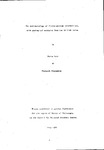THE SEDIMENTOLOGY OF FLUVIO-AEOLIAN INTERACTIONS, WITH GEOLOGICAL EXAMPLES FROM THE BRITISH ISLES
| dc.contributor.author | DODD, CHRIS | |
| dc.contributor.other | School of Geography, Earth and Environmental Sciences | en_US |
| dc.date.accessioned | 2013-09-16T08:57:39Z | |
| dc.date.available | 2013-09-16T08:57:39Z | |
| dc.date.issued | 1986 | |
| dc.identifier | NOT AVAILABLE | en_US |
| dc.identifier.uri | http://hdl.handle.net/10026.1/1726 | |
| dc.description.abstract |
In this study, both modern and ancient fan/fluvio-aeolian associations are reviewed. Criteria for recognition of ancient aeolian from fluvial deposits are defined. Four case studies were undertaken. Three are Middle to Upper Devonian sequences: a) The Caherbla Group, Dingle Peninsula, Eire, b) The Pointagare Group on the same peninsula, c) The Portishead Group, Avon. A Lower Permian sequence at Dawlish, Devon was also studied. The dune types in all four areas were barchan to transverse. Compound dunes (draa) occurred in the Caherbla and Portishead Groups. Some simple and compound dunes on the Caherbla dunefield margin were also reversing due to a topographic control of winds. The absence of longitudinal and star dune deposits i n the study areas reflects their apparent rarity in the geologic record. However models for their preservation in fluvio-aeolian sequences are presented. Evidence from both modern and ancient dunefields demonstrates that dune and/or dunefield relief frequently controls the drainage pattern. The fluvial systems most commonly found incursing into aeolian areas are shallow, sandy and braided, or sandy sheetflood. In more arid climates more gravelly ephemeral flood deposit s may occur, as in the Permian, Dawlish Sandstone Formation Climatic and tectonic events are recognised to trigger larger scale fan, fluvial or aeolian depositional pulses. Aeolian deposits may also accumulate at a specific phase during the basin history, when sand from an underlying fluvial deposit is available in large quantity. A suite of characteristic basin-scale patterns of fan/fluvio-aeolian inter-actions are identified. Finally, sufficient Middle to Upper Devonian aeolian sequences are now known to define a regional wind pattern for the southern British Isles during the mid-late Devonian, this is compatible with a location in the southern hemisphere trade wind belt. | |
| dc.language.iso | en | en_US |
| dc.publisher | University of Plymouth | en_US |
| dc.title | THE SEDIMENTOLOGY OF FLUVIO-AEOLIAN INTERACTIONS, WITH GEOLOGICAL EXAMPLES FROM THE BRITISH ISLES | en_US |
| dc.type | Thesis | |
| plymouth.version | Full version | en_US |
| dc.identifier.doi | http://dx.doi.org/10.24382/3735 | |
| dc.identifier.doi | http://dx.doi.org/10.24382/3735 |
Files in this item
This item appears in the following Collection(s)
-
01 Research Theses Main Collection
Research Theses Main


